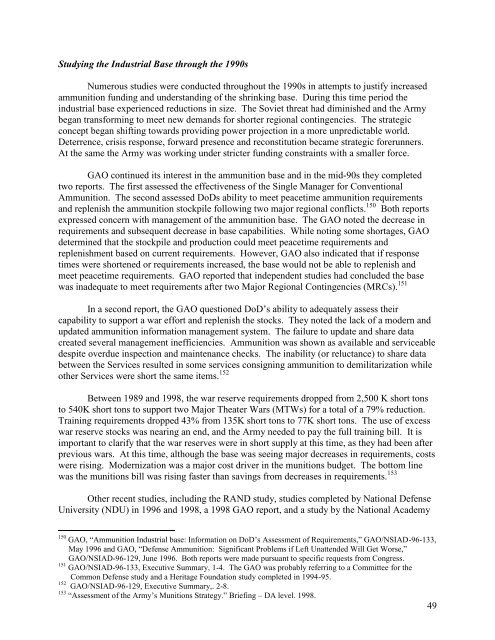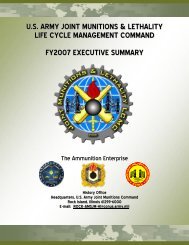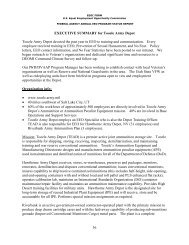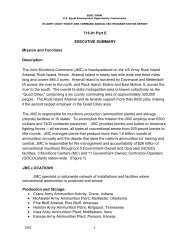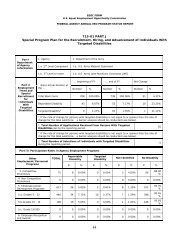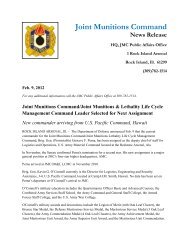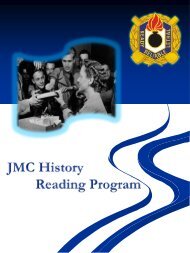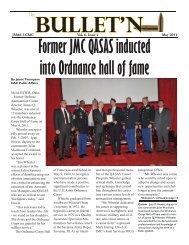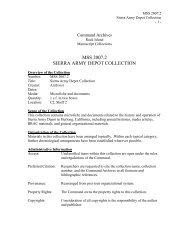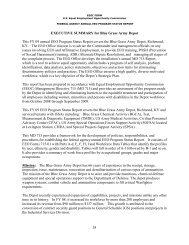History of the Ammunition Industrial Base - JMC - U.S. Army
History of the Ammunition Industrial Base - JMC - U.S. Army
History of the Ammunition Industrial Base - JMC - U.S. Army
Create successful ePaper yourself
Turn your PDF publications into a flip-book with our unique Google optimized e-Paper software.
Studying <strong>the</strong> <strong>Industrial</strong> <strong>Base</strong> through <strong>the</strong> 1990s<br />
Numerous studies were conducted throughout <strong>the</strong> 1990s in attempts to justify increased<br />
ammunition funding and understanding <strong>of</strong> <strong>the</strong> shrinking base. During this time period <strong>the</strong><br />
industrial base experienced reductions in size. The Soviet threat had diminished and <strong>the</strong> <strong>Army</strong><br />
began transforming to meet new demands for shorter regional contingencies. The strategic<br />
concept began shifting towards providing power projection in a more unpredictable world.<br />
Deterrence, crisis response, forward presence and reconstitution became strategic forerunners.<br />
At <strong>the</strong> same <strong>the</strong> <strong>Army</strong> was working under stricter funding constraints with a smaller force.<br />
GAO continued its interest in <strong>the</strong> ammunition base and in <strong>the</strong> mid-90s <strong>the</strong>y completed<br />
two reports. The first assessed <strong>the</strong> effectiveness <strong>of</strong> <strong>the</strong> Single Manager for Conventional<br />
<strong>Ammunition</strong>. The second assessed DoDs ability to meet peacetime ammunition requirements<br />
and replenish <strong>the</strong> ammunition stockpile following two major regional conflicts. 150 Both reports<br />
expressed concern with management <strong>of</strong> <strong>the</strong> ammunition base. The GAO noted <strong>the</strong> decrease in<br />
requirements and subsequent decrease in base capabilities. While noting some shortages, GAO<br />
determined that <strong>the</strong> stockpile and production could meet peacetime requirements and<br />
replenishment based on current requirements. However, GAO also indicated that if response<br />
times were shortened or requirements increased, <strong>the</strong> base would not be able to replenish and<br />
meet peacetime requirements. GAO reported that independent studies had concluded <strong>the</strong> base<br />
was inadequate to meet requirements after two Major Regional Contingencies (MRCs). 151<br />
In a second report, <strong>the</strong> GAO questioned DoD‟s ability to adequately assess <strong>the</strong>ir<br />
capability to support a war effort and replenish <strong>the</strong> stocks. They noted <strong>the</strong> lack <strong>of</strong> a modern and<br />
updated ammunition information management system. The failure to update and share data<br />
created several management inefficiencies. <strong>Ammunition</strong> was shown as available and serviceable<br />
despite overdue inspection and maintenance checks. The inability (or reluctance) to share data<br />
between <strong>the</strong> Services resulted in some services consigning ammunition to demilitarization while<br />
o<strong>the</strong>r Services were short <strong>the</strong> same items. 152<br />
Between 1989 and 1998, <strong>the</strong> war reserve requirements dropped from 2,500 K short tons<br />
to 540K short tons to support two Major Theater Wars (MTWs) for a total <strong>of</strong> a 79% reduction.<br />
Training requirements dropped 43% from 135K short tons to 77K short tons. The use <strong>of</strong> excess<br />
war reserve stocks was nearing an end, and <strong>the</strong> <strong>Army</strong> needed to pay <strong>the</strong> full training bill. It is<br />
important to clarify that <strong>the</strong> war reserves were in short supply at this time, as <strong>the</strong>y had been after<br />
previous wars. At this time, although <strong>the</strong> base was seeing major decreases in requirements, costs<br />
were rising. Modernization was a major cost driver in <strong>the</strong> munitions budget. The bottom line<br />
was <strong>the</strong> munitions bill was rising faster than savings from decreases in requirements. 153<br />
O<strong>the</strong>r recent studies, including <strong>the</strong> RAND study, studies completed by National Defense<br />
University (NDU) in 1996 and 1998, a 1998 GAO report, and a study by <strong>the</strong> National Academy<br />
150 GAO, “<strong>Ammunition</strong> <strong>Industrial</strong> base: Information on DoD‟s Assessment <strong>of</strong> Requirements,” GAO/NSIAD-96-133,<br />
May 1996 and GAO, “Defense <strong>Ammunition</strong>: Significant Problems if Left Unattended Will Get Worse,”<br />
GAO/NSIAD-96-129, June 1996. Both reports were made pursuant to specific requests from Congress.<br />
151 GAO/NSIAD-96-133, Executive Summary, 1-4. The GAO was probably referring to a Committee for <strong>the</strong><br />
Common Defense study and a Heritage Foundation study completed in 1994-95.<br />
152 GAO/NSIAD-96-129, Executive Summary,. 2-8.<br />
153 “Assessment <strong>of</strong> <strong>the</strong> <strong>Army</strong>‟s Munitions Strategy.” Briefing – DA level. 1998.<br />
49


